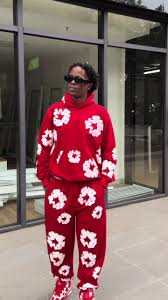Few fashion houses have altered the course of modern design as profoundly as Comme des Garcons. The brand’s founder, Rei Kawakubo, has spent over five decades challenging assumptions about what clothing should signify, how bodies should be represented, and where fashion fits within the cultural conversation. Comme des Garcons is not merely a label; it is a mindset—one that refuses conformity and insists that creativity must remain in perpetual motion.
Origins in Defiance
Comme des Garcons emerged in Tokyo in 1969, during a period when Western fashion ideals dominated global style. Kawakubo—who never attended fashion school—began designing out of necessity: she felt current garments did not align with her personal vision. The brand name, meaning “like the boys” in French, reflects an early commitment to dismantling gendered dress codes. Androgyny was not an aesthetic cliché for Kawakubo; it was a philosophical stance.
By the early 1970s, Comme des Garcons developed a stark, utilitarian look. Black clothing, distressed textures, and atypical silhouettes became signatures. Critics labeled the aesthetic severe, but loyal followers recognized its intellectual daring. Kawakubo believed beauty lies not in polish but in contrast, absence, and imperfection.
Paris: The Shockwave of 1981
The global fashion world truly encountered Comme des Garcons in Paris, 1981, when Kawakubo presented a collection that defied every glamorous norm. The models appeared ghostlike—shrouded in oversized, asymmetrical garments showcasing irregular shapes and raw finishes. The Western media responded with confusion and hostility. Terms such as “post-apocalyptic” and “destroyed chic” circulated widely.
Yet what unsettled critics ultimately reshaped fashion’s future. Kawakubo brought forth the idea of antifashion—clothing that questions the system instead of glorifying it. In retrospect, that debut marks a philosophical revolution: Comme des Garcons dismantled the rules and invited fashion to reexamine itself.
The Body Reimagined
Central to Comme des Garcons is the conviction that fashion must interrogate the body, not simply adorn it. Kawakubo has repeatedly challenged silhouette norms that idolize symmetry or emphasize the conventional hourglass figure. comme-des-garcons.uk
One of the most iconic and disruptive examples is the 1997 collection “Body Meets Dress, Dress Meets Body.” Rather than flattering the form, Kawakubo inserted padded distortions at the hips, shoulders, and torso. The garments forced observers to confront how society defines physical attractiveness. Was it still “wrong” if the garment expressed the wearer rather than pleasing the viewer?
Comme des Garcons invites people to see differently. Clothing becomes an interactive medium—something that shapes not only the body but the perception of identity itself.
Commercial Ecosystem, Conceptual Integrity
Despite a foundation in experimental design, Comme des Garcons has expanded into a multi-tiered business model with commercial success. Within the brand’s universe exist lines catering to differing lifestyles and budgets:
-
Comme des Garcons Homme Plus – innovative menswear with runway-level conceptual detail
-
Comme des Garcons PLAY – casual line featuring Filip Pagowski’s iconic red heart logo
-
Comme des Garcons SHIRT, Wallet, Noir, Girl, and others—each with a distinct design narrative
-
Comme des Garcons Parfums, redefining fragrance through unusual and industrial scent profiles
These extensions allow Kawakubo to support creative risk at the highest level while making the brand accessible to broader audiences. PLAY sneakers or logo tees may draw someone into the brand, but the avant-garde core remains untouched.
Crucially, Comme des Garcons also acts as a creative incubator. Designers such as Junya Watanabe and Kei Ninomiya developed under Kawakubo and built their own internationally respected labels within the CDG framework. The company helps ensure that radical ideas have the infrastructure needed to thrive.
Dover Street Market: Retail as Art
Retail innovation is another pillar of Comme des Garcons’ influence. In 2004, Kawakubo and business partner Adrian Joffe launched Dover Street Market (DSM)—a multibrand retail space curated like a living gallery. With locations in London, Tokyo, New York, Los Angeles, Singapore, and Beijing, DSM offers:
-
rotating installations by artists and designers
-
unexpected brand juxtapositions
-
retail layouts that intentionally disrupt conventional merchandising
DSM rejects passive consumption. Instead, the store becomes a dynamic cultural forum, reflecting how fashion interacts with art, architecture, and technology.
Perfume: The “Anti-Perfume” Philosophy
Comme des Garcons Parfums continues the anti-beauty tradition in olfactory form. Rather than predictable notes, Kawakubo’s fragrances embrace scents associated with dust, rubber, tar, or metal. Compositions like Odeur 71 referenced household appliances and photocopy fluid. These scents are abstract provocations, emphasizing that perfume need not be seductive or traditionally pleasant to be meaningful.
In this universe, fragrance becomes conceptual sculpture—experienced through scent rather than sight.
What the Runway Means to Comme des Garcons
A Comme des Garcons show is not storytelling in the traditional sense; it is theatrical philosophy. Models move slowly or ritualistically. Music, lighting, and staging often carry metaphorical weight—demonstrating not a new trend but a new idea.
Kawakubo avoids explaining collections in detail, believing that interpretation must remain ambiguous. Her restraint underscores a fundamental belief: fashion becomes richer when audiences think, question, and debate its meaning.
Legacy of an Uncompromising Vision
Rei Kawakubo’s impact extends beyond garments. She reshaped cultural understanding of:
-
Gender — clothing as a neutral medium
-
Imperfection — flaws as innovation
-
Consumerism — resisting the notion that fashion must charm to succeed
-
Beauty — constantly renegotiated rather than fixed
In 2017, the Metropolitan Museum of Art honored Kawakubo with a solo exhibition titled Rei Kawakubo / Comme des Garcons: Art of the In-Between. Only Yves Saint Laurent had received a similar tribute while living. This milestone affirmed what scholars and designers have long known: Kawakubo has redefined the role of fashion in society.
The Future Is Perpetual Experimentation
Comme des Garcons has never sought to repeat itself. Each season disrupts the last; progress is measured in transformation, not approval. As Kawakubo herself has said, “The only constant is change.”
That commitment to risk ensures the brand’s continued relevance. While others chase trends, Comme des Garcons creates new forms of thought, converting the runway into a laboratory of human expression.

